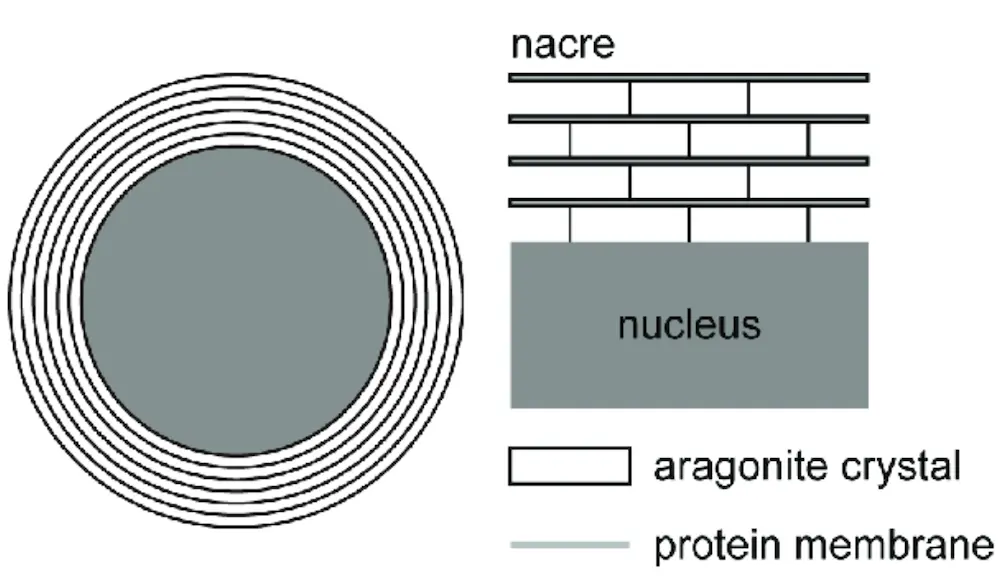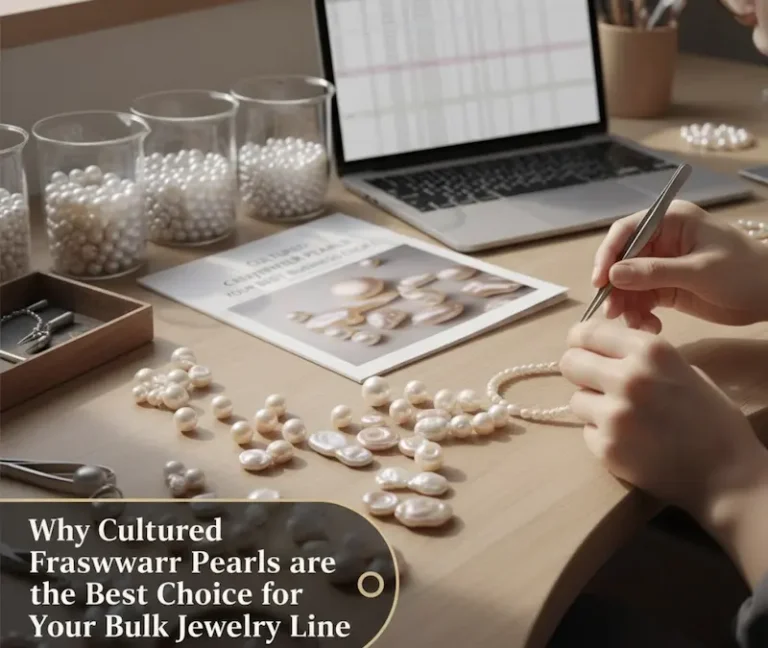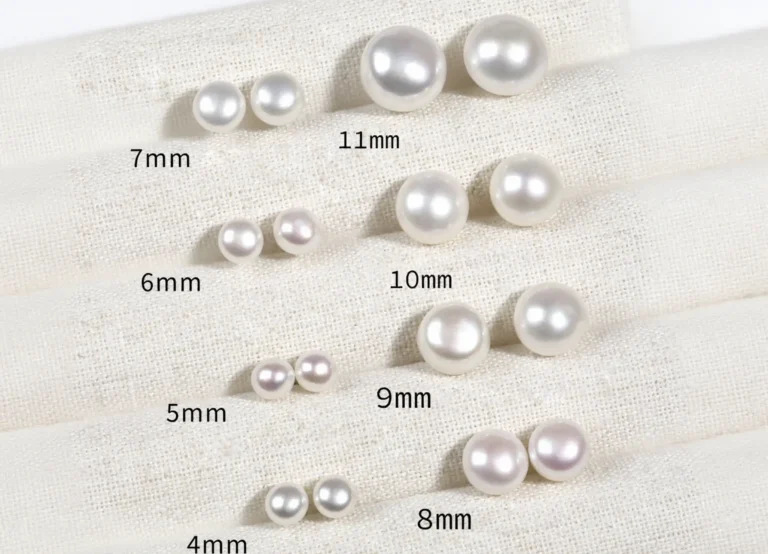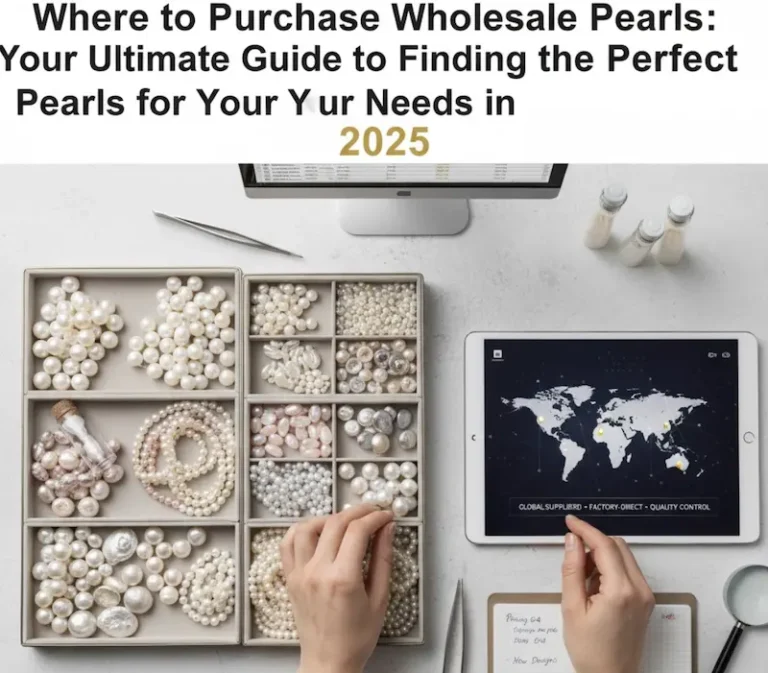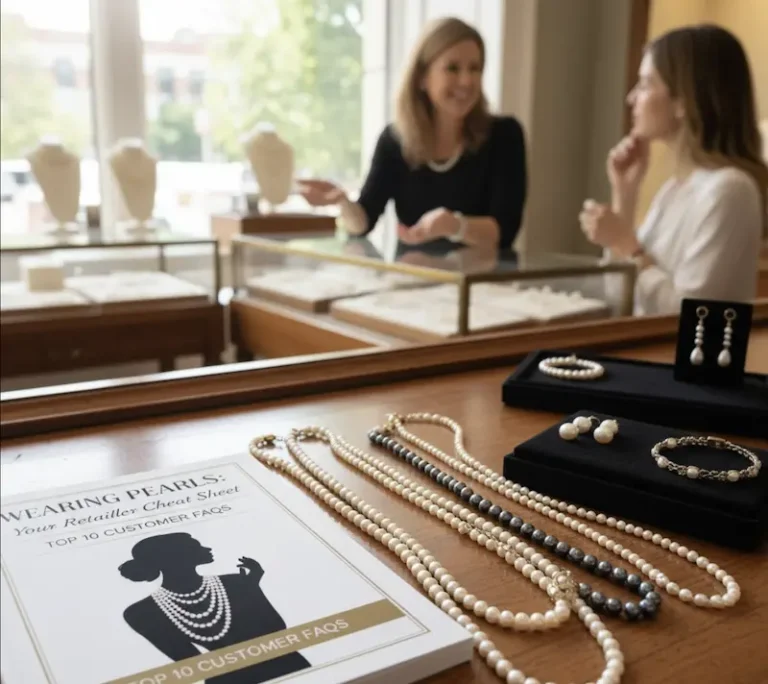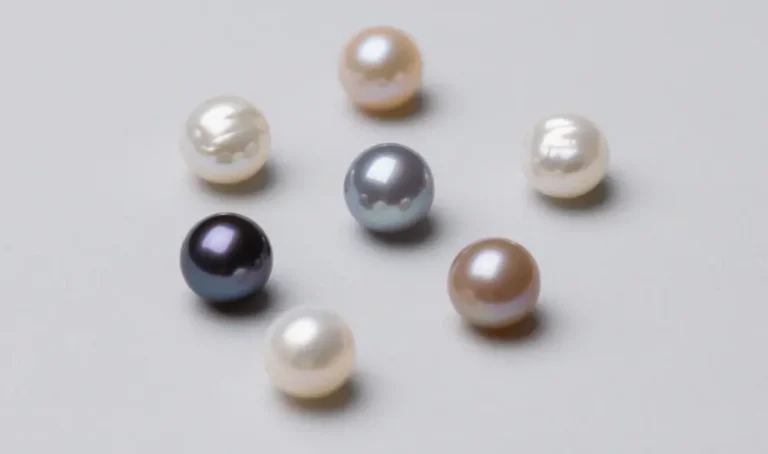Have you ever held a shiny pearl and thought about where it came from? What are pearls actually made of? How do these pearls grow inside living things? The answer is more interesting than you might think! Nacre is a shiny substance that is mostly made of aragonite (calcium carbonate) and conchiolin. It makes up thousands of tiny layers that make up pearls.These are the same materials that create the shimmering inside of oyster shells.

You know, unlike things like diamonds and rubies that take ages to form way down in the earth, pearls are actually “living gems.” Mollusks create them naturally as a way to protect themselves. It’s a pretty incredible process that’s captivated people for a long, long time, which is why pearls are one of the most treasured gemstones around. It makes you wonder, what are pearls actually made of?
7 Facts About What Are Pearls Actually Made Of
Fact1: What Exactly Composes a Pearl’s Structure
If you really want to know what are pearls actually made of, you’ll find it’s a pretty complex biological wonder. This special mix is what makes pearls so special. These super thin hexagonal layers of aragonite crystals are only about 0.5 micrometers thick! These layers make light bounce and bend, which is what gives pearls their famous shine and iridescent shimmer. And the conchiolin? That makes them a little more flexible so they don’t break too easily, even though they are mostly made of minerals.
This special mix makes pearls different from each other. These super thin, hexagonal layers of aragonite crystals are only about 0.5 micrometers thick! These layers reflect and refract light, giving pearls their famous shine and iridescent shimmer. And what about the conchiolin? That lets them bend a little, so they don’t get too brittle, even though most of them are minerals.
| Pearl Component | Percentage | Function |
|---|---|---|
| Aragonite (Calcium Carbonate) | ~95% | Provides hardness and optical properties |
| Conchiolin (Organic Protein) | ~5% | Acts as binding agent and provides flexibility |
| Water | ~2-4% | Maintains structural integrity |
So, this is how they form: the mollusk secretes those things in layers, like paint, around something that bothers it. This is a fundamental part of answering what are pearls actually made of. The pearl gets bigger and better at reflecting light with each layer. That’s why cultured pearls from a good Pearl Manufacturer can be just as good as natural ones. The process of making them is basically the same, whether it happens on its own or with a little help.
The Microscopic Architecture of Pearl Formation
The stuff pearls are made of gets even more interesting when you look at their microscopic structure up close. This is a key part of understanding what are pearls actually made of. There are tiny aragonite tablets in each layer of nacre that are lined up like bricks in a wall. Conchiolin acts as the mortar that holds them all together. This “brick and mortar” design is what makes pearls so strong. In fact, they can be up to 3,000 times stronger than the materials they are made from!
The way these tiny parts are put together is what really makes a pearl look the way it does. The pearl’s shine depends on how thick and evenly the aragonite layers are laid down. The colors you see on the surface change because of small differences in how the crystals line up.
Fact 2: How Different Mollusks Create Pearls
Remember that not all pearls are the same. The answer to what are pearls actually made of can be different depending on where they come from. Some sea snails, freshwater mussels, and sea oysters all make pearls, but the pearls they make are all a little different in terms of what they’re made of and how they’re put together.
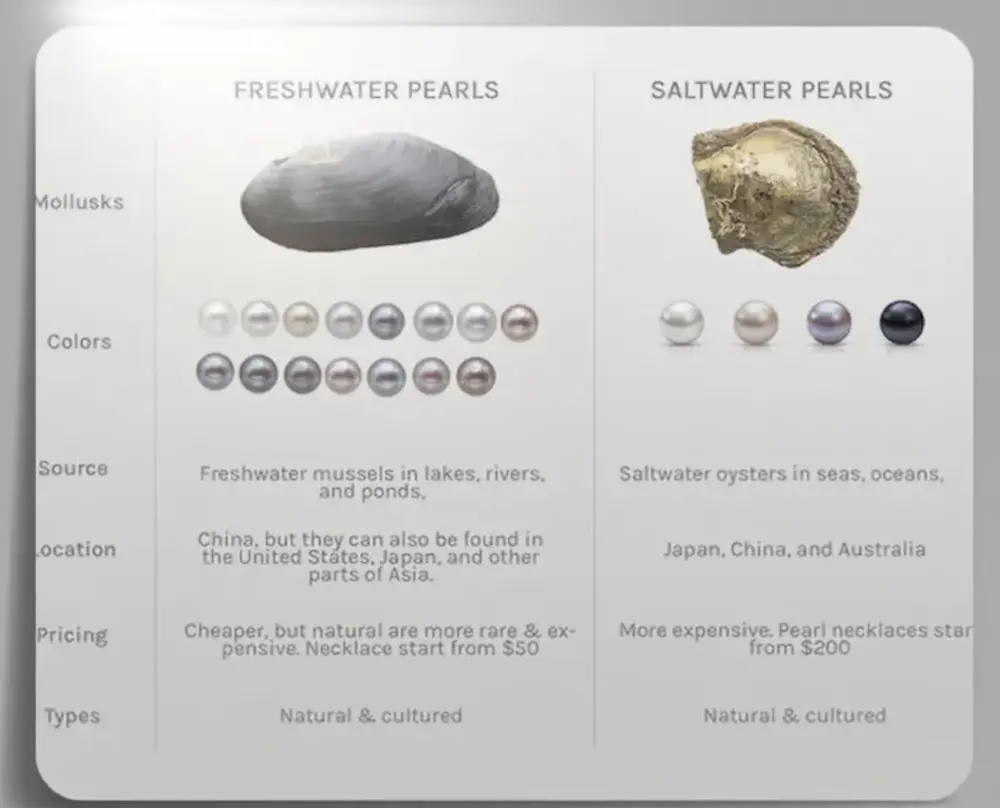
Saltwater pearls, especially those from Pinctada oysters, generally have thicker layers of nacre and a more organized arrangement of aragonite crystals. This makes them shinier and more durable. You’ll notice this difference in the wholesale pearl market, where South Sea and Tahitian pearls fetch higher prices because of their exceptional nacre quality.
Freshwater pearls, the kind made by mussels in lakes and rivers, often have a different mix of minerals because the water they grow in varies. This can cause the pearl to have slightly different amounts of aragonite and conchiolin, which can change how it looks and how long it lasts.
Non-Nacreous Pearl Varieties
It’s also interesting to note that not all pearls are made of the same stuff. Some shellfish create “pearls” that aren’t nacreous. Instead of being made of aragonite, like most pearls, they’re primarily made of calcite. Take conch pearls, for example, which come from the Queen Conch sea snail. These are mostly calcite, and their fibrous structure gives them that unique “flame” pattern.
| Pearl Type | Primary Composition | Source Mollusk | Distinctive Features |
|---|---|---|---|
| Nacreous Marine | Aragonite + Conchiolin | Saltwater oysters | High luster, round shape |
| Nacreous Freshwater | Aragonite + Conchiolin | River mussels | Various shapes, lower luster |
| Conch | Calcite fibers | Queen Conch gastropod | Pink/orange color, flame patterns |
| Melo Melo | Calcite + organic matrix | Sea snail | Orange/brown, porcelain-like |
Fact 3: The Formation Timeline: How Long Does Nature’s Magic Take
To really understand what are pearls actually made of , you have to look at how long it takes them to form. With natural pearls, even a small one takes 2-4 years to develop! It can take 5 to 20 years for bigger ones to fully grow. Over time, the mollusk adds layers of nacre, and it takes several days to finish each layer.
During this long growth period, the environment has a big impact on the makeup of the pearl. The nacre is secreted differently depending on the temperature of the water, how salty it is, how much food is available, and even the seasons. The nacre usually settles faster in warmer water, but in cooler water, the layers are thicker and shinier.
Pearl farms really do keep a close eye on these things to make sure they get the best pearls possible. Most of the pearl necklaces you see in stores today have pearls that were grown for one to three years, depending on the size and quality they want.
Environmental Factors Affecting Pearl Composition
The place where a pearl grows has a big effect on its makeup, even down to the tiny trace elements and the way its crystals are arranged. Gemologists can tell pearls apart by their mineral “fingerprints,” which are unique to each pearl. For instance, pearls from the Persian Gulf usually have a different mix of trace elements than pearls from the South Pacific.
These environmental factors also play a role in a pearl’s color and shine. What the oyster eats, the minerals in the water, and even things like pollution can change the makeup and look of the nacre.
Fact 4: Are Real Pearls Truly Cruelty-Free?
A question that often comes up when discussing what pearls are actually made of is whether pearl harvesting is ethical. Do oysters have to die to get the pearls? Sadly, when harvesting natural pearls the traditional way, the oyster usually has to be opened, which kills it to get the pearl out.
But things have changed a lot with modern pearl farming. Now, when pearls are cultivated, the oysters often survive the process of having something inserted to encourage pearl growth, and they can keep living even after the pearl is taken out. Some farms that are ahead of the curve are even trying out new ways to get the pearl out of the oyster without hurting it.
The issue of sustainability is not limited to individual oysters; it impacts the entire underwater ecosystem. Pearl farms that do the right thing can help the ocean by keeping the water clean and the oyster populations healthy. The Marine Conservation Society says that well-run pearl farms can help the environment by making the water cleaner and increasing biodiversity.
Modern Ethical Pearl Farming Practices
More and more, modern pearl farming is about doing things that don’t hurt the environment. A lot of farms are now:
- Picking the right oysters to breed so that they make more pearls without hurting wild oyster populations.
- Checking the water quality often to keep the ecosystem healthy.
- Moving farming areas around so that the same marine area isn’t used too much.
- Finding ways to help oysters live after the pearl is taken out.
Fact 5: Why Pearls Command Such High Prices
Understanding what pearls are made of really gets to the heart of what makes them valuable. The complicated way they’re formed by living creatures, the time it takes, and their unique, organic makeup all contribute to their inherent value. Natural pearls are very hard to find. In the past, divers might have had to look through hundreds of oysters to find one pearl that was good enough to be a gem.
What makes pearls even rarer is that they need very specific conditions to form. Not everything that gets inside an oyster will cause it to create a pearl. And even when it does, the pearl might end up being oddly shaped or not very shiny. According to National Geographic, less than 1% of wild oysters actually produce pearls that are good enough to be considered gems.
It’s cheaper to make cultured pearls, but it still takes a lot of time, money, and skill. To start the process of making pearls in oysters, skilled workers are needed. It takes 2 to 4 years for the pearls to grow. This means that a lot of money is tied up before any profits are made.
Market Factors Influencing Pearl Prices
| Quality Factor | Impact on Price | Related to Composition |
|---|---|---|
| Luster | High – 40% of value | Nacre layer quality and thickness |
| Surface Quality | High – 25% of value | Consistency of aragonite deposition |
| Shape | Medium – 20% of value | Nucleation technique and mollusk health |
| Size | Medium – 10% of value | Formation time and nacre accumulation |
| Color | Low – 5% of value | Trace elements and organic compounds |
Understanding what pearls are made of helps explain why their prices vary so much. The thickness of the nacre (the coating that makes up the pearl) directly affects its shine and how long it will last. Pearls with thick nacre are more valuable. Also, any imperfections on the surface, which often happen because of uneven nacre layers, will lower the pearl’s value.
Fact 6: The Science Behind Pearl Colors and Luster
What’s really interesting is how the stuff pearls are made of affects how they look, which is a key part of answering the question, what are pearls actually made of? The aragonite crystals inside the nacre create patterns that mess with light as it passes through. This creates a rainbow-like effect, called “orient,” that makes the colors seem to shift and shimmer on the pearl’s surface.
Small amounts of other elements that get mixed in while the pearl is forming can also change its basic color. Iron can make colors look more golden, while silver can make them look darker. And the thickness of each layer of nacre also has an effect on the color we see. Thinner layers tend to make blues and greens stand out, while thicker layers make the colors warmer.
Conchiolin, an organic substance, gives pearls their “warmth.” This is what makes them different from gemstones, which are made up of minerals. This natural substance makes pearls shine softly and gently, which is different from the sharp sparkle of diamonds or the bright, fiery colors of opals.
Understanding Pearl Surface Phenomena
The way that pearls are made and how they look work together to create a number of unique optical effects:
- Luster: The surface of nacre reflects light like a mirror, which depends on how smooth and even the layers of aragonite crystals are.
- Orient: The way the colors change on the surface of the pearl because of light bouncing off of nacre layers.
- Overtone: Secondary colors that seem to float just below the surface of the pearl. This happens when the pearl’s base color and the nacre’s optical properties interact.
Fact 7: Natural vs. Cultured: Composition Differences
When we’re looking at what are pearls actually made of, it’s important to distinguish between natural and cultured pearls. Both types are made of aragonite and conchiolin, but the way they form makes them a little different from each other.
Natural pearls tend to have less organized nacre layers because they form in the wild in a more random way. These flaws can sometimes make them more valuable because they have unique looks that you can’t find in cultured pearls.
Cultured pearls grow in controlled settings, which helps them make nacre layers that are more even. This means that their quality is usually more consistent, but they might not have the same unique differences that natural pearls do. Natural pearls are made entirely of nacre, but cultured pearls have a core because they are “seeded” with a mother-of-pearl bead.
Gemologists can now tell the difference between natural and cultured pearls by using X-rays. The X-rays show the inside structure and can tell you exactly what each pearl is made of.
Caring for Your Pearls: Protecting Their Unique Composition
Knowing what are pearls actually made of is super important for taking care of them. Because they contain organic stuff (conchiolin), they’re more easily damaged by things like acids, extreme heat, and certain chemicals, compared to gemstones that are purely mineral.
The calcium carbonate in them can even dissolve if exposed to acidic things like lemon juice, vinegar, or even too much sweat. That’s why you should wipe your pearls with a soft, damp cloth after wearing them and store them separately from your other jewelry.
Pearls can also dry out and lose their shine or crack over time because they are made of organic materials.Wearing them occasionally is actually good for them, because it exposes them to your skin’s natural oils, which help keep those organic components healthy.
When you store pearls, keep them in something breathable, not an airtight plastic bag. The best storage environment has a moderate amount of humidity, which keeps their organic parts healthy without encouraging bacteria to grow.
The Future of Pearl Science and Innovation
We learn more about how living things make minerals when we study what are pearls actually made of. Scientists are looking into how mollusks control the growth of aragonite crystals in the hopes of being able to use these processes in industry.
Researchers in nanotechnology have found that the “brick and mortar” structure of pearls is leading to the development of new materials that are very strong and light. Understanding how nacre forms could lead to big changes in how we make things.
Genetic research on pearl-producing mollusks aims to improve the quality of nacre and speed up its formation. While still in the experimental stages, these advances could make top-quality pearls more available while preserving their natural beauty and unique makeup.
Using pearls to monitor water quality is another exciting possibility. Because what pearls are made of reflects the environment they grow in, scientists can analyze their composition to track past changes in marine ecosystems.
New things are always coming to light about these amazing gems thanks to a mix of old knowledge and new science. The more we understand what are pearls actually made of, the more we appreciate the complicated ways that these sea treasures are created.
FAQs
Are oysters killed when pearls are removed?
Usually, yes—opening the shell is fatal, so the meat becomes by-product.
Are pearls cruelty free?
Not really; the mussel/oyster dies and the process stresses it, so vegans skip them.
Is it true that oysters make pearls?
Yes—mussels and oysters coat irritants with nacre, creating the pearl.
Is making pearls painful for oysters?
They have simple nervous systems, so it’s stress rather than “pain” as we feel it—but they still die at harvest.

